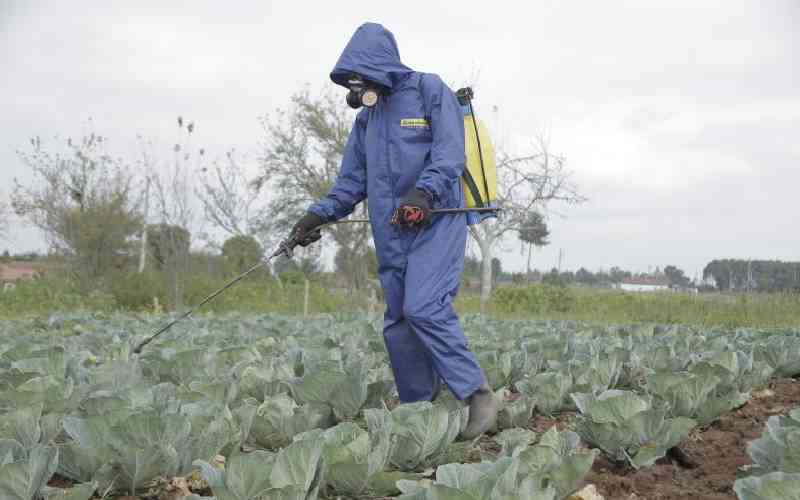
Spray Service Provider John Kamau during the application of pesticides in a cabbage farm, on July 11, 2024. [File, Standard]
The majority of farmers in Marsabit County continue to rely on cheaper synthetic pesticides to control pests and diseases affecting their crops.
Sara Omare, the deputy sub-county administrator, says most of these synthetic pesticides are smuggled into Kenya from Ethiopia through unguarded and porous border points.
“As long as cheap synthetic pesticides continue to come from Ethiopia, it will be difficult for farmers to adopt alternatives like biopesticides, which are relatively more expensive,” Omare says, during the second Biopesticides Policy workshop organised by Cordaid.
Although biopesticides are available in the market, many farmers remain either unaware of their existence or uncertain about how to use them effectively.
It is against this backdrop that stakeholders set out to find ways to strengthen biopesticides policies, with a focus on raising awareness and promoting greater adoption among farmers.
Just like in Marsabit, millions of farmers across the country tend to choose cheaper alternatives.
Wycliff Nyamao, project Officer at the Kenya Organic Agriculture Network (KOAN), notes that cost plays a major role in farmers’ decisions.
“When it comes to production, farmers will naturally choose the most affordable option, often without considering the long-term environmental impact,” he said.
Nyamao emphasised the influence of government subsidies on farmers’ choices: “When the government subsidises conventional farming inputs such as fertilisers and synthetic pesticides, it shifts farmers toward these products.”
To counter this, he explained, the government should offer even greater support for organic alternatives and subsidise biopesticides to promote their use.
He praises, which improve overall environmental conditions, enhance soil structure and maintain nutrient balance sustainably. They also protect interconnected ecosystems, including aquatic and terrestrial environments.
“When you use biopesticides, you’re not only boosting productivity but also positively impacting the environment. Synthetic pesticides often contain persistent chemicals that can move through the food chain, risks that are significantly reduced with biopesticides,” he added.
He noted that the government has not played a significant role in raising awareness about the use and benefits of biopesticides. Instead, most awareness efforts have been led by NGOs and private sector actors.
Stay informed. Subscribe to our newsletter
Dr Zachary Kinyua, coordinator of crop health research at the Kenya Agricultural and Livestock Research Organisation (Kalro), acknowledged that while the legal framework for biopesticides use exists through the Pest Control Products Board (PCPB), uptake remains low.
“What needs to be addressed is the root cause behind the limited popularity and large-scale adoption of biopesticides among both small and large-scale farmers,” he says, adding that understanding these root causes is essential to breaking down barriers to adoption.
He warned against relying solely on any single pest or disease control method. “We must adopt Integrated Pest Management (IPM), which combines multiple strategies. Biopesticides are one component within this broader approach.”
Alternatively, farmers use pest-resistant plant varieties and clean planting material to reduce infestations.
Dr Kinyua believes that one of the reasons for the low uptake is that biopesticides are slower-acting and less immediately effective compared to synthetic pesticides.
Farmers often prefer products that deliver fast results. Synthetic pesticides are marketed as quick solutions, and there’s a strong private sector presence pushing their use, including agronomists on the ground.
“Unfortunately, there’s no equivalent force advocating for biopesticides. Unless farmers are educated about their benefits, especially in terms of safety for humans, livestock, and the environment, their demand will remain low,” Dr Kinyua said.
Dr Wakhungu Hillary, a policy analyst from the Kenya Institute of Public Policy Research and Analysis (KIPPRA), argues that rather than creating a separate biopesticides policy, the country should develop a Biopesticides Action Plan.
Such a plan, he said, would outline concrete steps for improving registration, awareness, local manufacturing, and usage of biopesticides.
This can include streamlining the registration process by recognising existing global data, creating incentives for local production and innovation, and building institutional capacity through collaboration with universities and research bodies.
Others are establishing public-private partnerships to fund research, testing, and commercialisation and enhancing coordination among ministries, including agriculture, health, trade and environment.
He’s also identified a critical gap in the current registration pathway for biopesticides through PCPB.
“Right now, it involves Forms A1, A2, and A3, with 23 steps required to complete the registration. It’s a lengthy and costly procedure, especially for local manufacturers and MSMEs,” he explained.
Testing is vital to ensure food safety, but the costs of scientific research, including lab equipment, reagents and skilled personnel, are usually borne by innovators.
Stakeholders consistently cite the lengthy and expensive registration process as a major barrier, especially due to the number of tests required from various institutions.
The success of any biopesticides initiative depends on collaboration across multiple ministries, not just Agriculture.
There is a need to involve the Ministries of Health, Trade, Innovation, Technology, and Environment.







